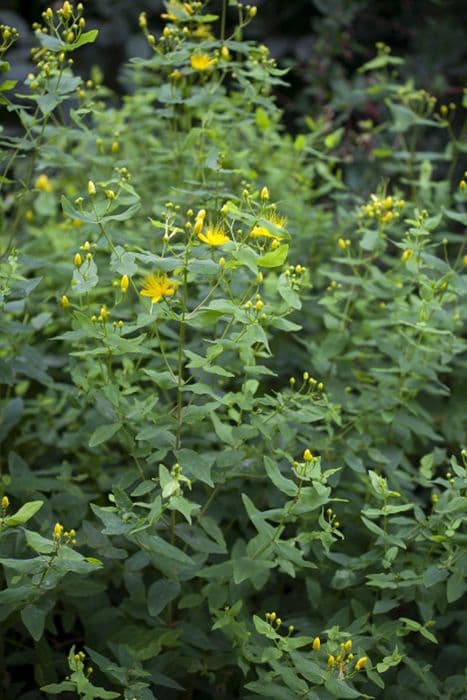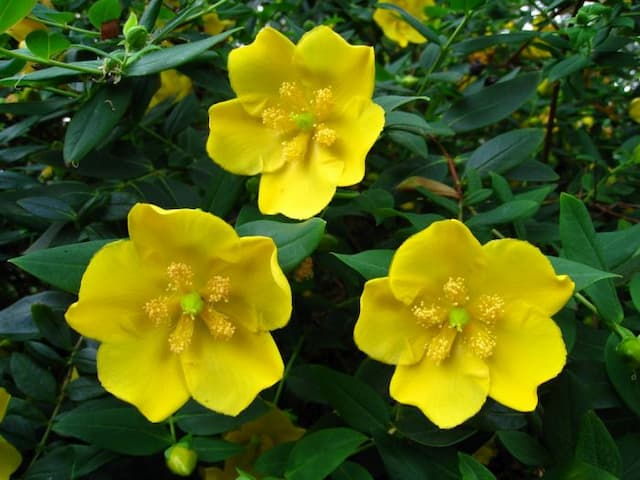Gold Cup St. John's Wort Hypericum × cyathiflorum 'Gold Cup'

ABOUT
Hypericum × cyathiflorum 'Gold Cup', commonly known as Saint John's Wort 'Gold Cup', is a flowering plant that exhibits a lush green appearance with a dense, bushy growth habit. The leaves are elongated and oval-shaped with a rich green color and may show a subtle, attractive texture. When the plant blooms, it produces abundant, bright yellow flowers that have a prominent, sun-like appearance which gives the 'Gold Cup' its name. The flowers are characterized by their numerous, long stamens that radiate from the center, giving the blossoms a frilly, ornamental look. These cheerful blooms can add a splash of color to any garden setting. The contrast between the vibrant yellow flowers and the dark green foliage creates a striking visual effect. After flowering, the plant may produce small, reddish-brown fruit capsules which add further interest to its appearance. Overall, this plant's visual appeal lies in its foliage and especially in its radiant gold blooms.
About this plant
 Names
NamesFamily
Hypericaceae
Synonyms
Gold Cup St. John's Wort, Hybrid St. John's Wort, Cyathiflorum St. John's Wort
Common names
Hypericum × cyathiflorum 'Gold Cup'.
 Toxicity
ToxicityTo humans
St. John's Wort is generally considered non-toxic to humans in small quantities. However, as with many plants, ingestion in large amounts may lead to adverse effects such as gastrointestinal irritation, confusion, tiredness, and sensitivity to sunlight. Care should be taken as individual sensitivity to plants can vary.
To pets
St. John's Wort can be toxic to pets, particularly to cats and dogs if ingested. The symptoms of poisoning can include gastrointestinal upset, lethargy, and photosensitization, which is an increased sensitivity to sunlight. In severe cases, it may lead to skin blistering or neurological issues, so it is important to prevent pets from ingesting this plant.
 Characteristics
CharacteristicsLife cycle
Perennials
Foliage type
Deciduous
Color of leaves
Green
Flower color
Yellow
Height
2-3 feet (0.6-0.9 meters)
Spread
2-3 feet (0.6-0.9 meters)
Plant type
Shrub
Hardiness zones
5
Native area
Cultivar
Benefits
 General Benefits
General Benefits- Attracts Pollinators: Hypericum × cyathiflorum 'Gold Cup', commonly known as the Gold Cup St. John's Wort, invites bees and butterflies to the garden, thus supporting pollination.
- Landscape Beautification: With its bright yellow flowers, this plant adds vibrant color and aesthetic appeal to gardens and landscapes.
- Erosion Control: Gold Cup St. John's Wort can help stabilize soil and prevent erosion due to its rooting system.
- Drought Tolerance: Once established, it is relatively drought-tolerant, requiring minimal watering and maintenance.
- Adaptability: It can adapt to a variety of soil types, although it prefers well-drained soils, making it versatile for different garden settings.
- Wildlife Habitat: Provides a natural habitat for small wildlife and insects, contributing to ecological diversity.
 Medical Properties
Medical PropertiesThis plant is not used for medical purposes.
 Air-purifying Qualities
Air-purifying QualitiesThis plant is not specifically known for air purifying qualities.
 Other Uses
Other Uses- Photography backdrop: The vibrant yellow flowers of St. John's wort can create a stunning and natural background for outdoor portrait photography.
- Artistic inspiration: Artists may use the plant as subject matter for paintings, drawings, or printmaking due to its striking appearance.
- Craft projects: Dried flowers and stems of St. John's wort can be used in creating wreaths, dried floral arrangements, or potpourri.
- Natural dye: The flowers and leaves of St. John's wort can be used to produce a reddish or golden dye for fabrics and yarn.
- Educational tool: St. John's wort can be used in botany classes to teach plant identification and the characteristics of the Hypericaceae family.
- Garden photography: Due to its showy flowers, St. John's wort is an excellent subject for botanical photography and garden documentation.
- Festive decoration: Fresh or dried flowers can be used to adorn tables or rooms during festive occasions, especially in summer celebrations.
- Ecological studies: St. John's wort can be used in studies observing pollinator preferences and plant-pollinator interactions.
- Culinary garnish: Although not commonly used for consumption, the flowers could be used as a garnish for salads or desserts to add a splash of color (it is always important to make sure any plant material used in food is safe and non-toxic).
Interesting Facts
 Feng Shui
Feng ShuiThe St. John's Wort is not used in Feng Shui practice.
 Zodiac Sign Compitability
Zodiac Sign CompitabilityThe St. John's Wort is not used in astrology practice.
 Plant Symbolism
Plant Symbolism- Protection: Hypericum, also known as St. John's Wort, is traditionally associated with warding off evil spirits and protecting against negative influences.
- Healing: The plant has been used for its medicinal properties to treat wounds and various health ailments, symbolizing physical and emotional healing.
- Strength: Its hardy nature and ability to thrive in tough conditions represent strength and resilience.
- Happiness: St. John's Wort is known for its bright yellow flowers that resemble the sun, symbolizing light, positivity, and the banishment of darkness.
- New beginnings: The plant’s association with midsummer celebrations suggests rebirth and the start of new endeavors.
 Water
WaterThe St. John's Wort 'Gold Cup' prefers consistently moist soil, so it should be watered regularly to maintain moisture but not waterlogged. Provide about 1 inch of water per week, depending on weather conditions and soil type; more water may be needed during hot, dry periods and less during wet, cool periods. It's important to water deeply to encourage root growth, so applying the water directly to the base of the plant and ensuring that it reaches the roots is the best method. Avoid overhead watering to minimize the risk of leaf diseases. During the winter, reduce watering as the plant's growth slows down.
 Light
LightSt. John's Wort 'Gold Cup' thrives in full sun to partial shade. It performs best when it receives at least 6 hours of direct sunlight per day, but it can also tolerate some light afternoon shade. The ideal spot for it is one where morning sunlight can reach it, which provides ample light while protecting it from the intense heat of the late afternoon sun.
 Temperature
TemperatureSt. John's Wort 'Gold Cup' is resilient to a range of temperatures but grows best in conditions between 60°F and 70°F. It can survive minimum temperatures down to about 10°F; however, it needs protection from frost. The plant can also handle high summer temperatures as long as it is well-watered, but prolonged heat above 80°F can stress the plant.
 Pruning
PruningPruning St. John's Wort 'Gold Cup' is necessary to maintain its shape and to encourage bushier growth and more flowers. Prune in early spring, cutting back about a third of the older stems to the ground to stimulate new growth. Additionally, after flowering, you can trim the plant to remove spent flowers and any unruly branches to promote a second bloom and keep the plant looking tidy.
 Cleaning
CleaningAs needed
 Soil
SoilThe Gold Cup prefers well-draining soil rich in organic matter, with a slightly acidic to neutral pH between 5.5 and 7. A mixture of loamy soil, peat, and sand or perlite can create an ideal environment for this plant.
 Repotting
RepottingGold Cups should be repotted every 2 to 3 years to refresh the soil and accommodate root growth, ideally in spring before the onset of vigorous growth.
 Humidity & Misting
Humidity & MistingGold Cup thrives in average room humidity levels; however, it can benefit from a slight increase during the dry winter months, aiming for around 40-50% relative humidity.
 Suitable locations
Suitable locationsIndoor
Provide bright indirect light and water when topsoil is dry.
Outdoor
Plant in part shade and well-draining soil; mulch to retain moisture.
Hardiness zone
5-9 USDA
 Life cycle
Life cycleHypericum × cyathiflorum 'Gold Cup', commonly known as the Gold Cup St. John's Wort, begins its life cycle as a seed, which germinates in moist, well-drained soil in early spring. The seedling emerges and develops into a young plant, exhibiting characteristic glossy green leaves. As the plant matures, it enters the vegetative growth stage, during which it develops a robust root system and woody stems. During the flowering stage, typically in mid to late summer, the plant produces numerous bright yellow flowers with a prominent, bushy appearance. After pollination, these flowers develop into small, berry-like capsules containing seeds, which, when mature, are dispersed by wind, water, or wildlife to propagate the next generation. In autumn, the plant may enter a period of dormancy, with above-ground growth dying back, to re-emerge the following spring.
 Propogation
PropogationPropogation time
Early Spring
The St. John's Wort cultivar Hypericum × cyathiflorum 'Gold Cup' can be propagated by semi-hardwood cuttings during summer. The most popular method involves selecting healthy, non-flowering stems and cutting them into lengths of 4 to 6 inches (approximately 10 to 15 cm). Each cutting should have several leaves and be dipped in rooting hormone powder to encourage root development. The prepared cuttings are then placed in a moist potting mix, ensuring at least one or two nodes are buried where roots will form. The pot should be kept in a warm, bright area but out of direct sunlight and the soil should be kept consistently moist. Roots typically develop in several weeks, after which the new plants can be transplanted into individual pots and grown on until they are sturdy enough to plant out in the garden.









